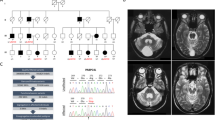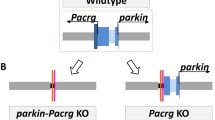Abstract
1. Mouse lines lacking prion protein (PrPC) have a puzzling phenotypic discrepancy. Some, but not all, developed late-onset ataxia due to Purkinje cell degeneration.
2. Here, we identified aberrant mRNA species in the brain of Ngsk Prnp 0/0 ataxic, but not in nonataxic Zrch Prnp 0/0 mouse line. These mRNAs were chimeric between the noncoding exons 1 and 2 of the PrP gene (Prnp) and the novel sequence encoding PrP-like protein (PrPLP), a putative membrane glycoprotein with 23% identity to PrPC in the primary amino acid structure. The chimeric mRNAs were generated from the disrupted Prnp locus of Ngsk Prnp 0/0 mice lacking a part of the Prnp intron 2 and its splice acceptor signal.
3. In the brain of wild-type and Zrch Prnp 0/0 mice, PrPLP mRNA was barely detectable. In contrast, in the brain of Ngsk Prnp 0/0 mice, PrP/PrPLP chimeric mRNAs were expressed in neurons, at a particularly high level in hippocampus pyramidal cells and Purkinje cells under the control of the Prnp promoter.
4. In addition to the functional loss of PrPC, ectopic PrPLP expression from the chimeric mRNAs could also be involved in the Purkinje cell degeneration in Ngsk Prnp 0/0 mice.
Similar content being viewed by others
REFERENCES
Antoniou, M., Geraghty, F., Hurst, J., and Grosveld, F. (1998). Efficient 3'-end formation of human β-globin mRNA in vivo requires sequences within the last intron but occurs independently of the splicing reaction. Nucleic Acids Res. 26:721–729.
Büeler, H., Aguzzi, A., Sailer, A., Greiner, R. A., Autenried, P., Aguet, M., and Weissmann, C. (1993). Mice devoid of PrP are resistant to scrapie. Cell 73:1339–1347.
Büeler, H., Fischer, M., Lang, Y., Bluethmann, H., Lipp, H. P., DeArmond, S. J., Prusiner, S. B., Aguet, M., and Weissmann, C. (1992). Normal development and behaviour of mice lacking the neuronal cell-surface PrP protein. Nature 356:577–582.
Gunderson, S. I., Beyer, K., Martin, G., Keller, W., Boelens, W. C., and Mattaj, L. W. (1994). The human U1AsnRNP protein regulates polyadenylation via a direct interaction with poly(A) polymerase. Cell 76:531–541.
Manson, J. C., Clarke, A. R., Hooper, M. L., Aitchison, L., McConnell, I., and Hope, J. (1994a). 129/Ola mice carrying a null mutation in PrP that abolishes mRNA production are developmentally normal. Mol. Neurobiol. 8:121–127.
Manson, J. C., Clarke, A. R., McBride, P. A., McConnell, I., and Hope, J. (1994b). PrP gene dosage determines the timing but not the final intensity or distribution of lesions in scrapie pathology. Neurodegeneration 3:331–340.
Moore, R. (1997). Gene targeting studies at the mouse prion protein locus [dissertation]. University of Edinburgh, Edinburgh, Scotland.
Moore, R. C., Lee, I. Y., Silverman, G. L., Harrison, P. M., Strome, R., Heinrich, C., Karunarantne, A., Pasternak, S. H., Chishti, M. A., Liang, Y., Mastrangelo, P., Wang, K., Smit, A. F. A., Katamine, S., Carlson, G. A., Cohen, F. E., Prusiner, S. B., Melton, A. W., Tremblay, P., Hood, L. E., and Westaway, D. (1999). Ataxia in prion protein (PrP) deficient mice associated with upregulation of the novel PrP-like protein doppel. J. Mol. Biol. 292:797–817.
Nishida, N., Tremblay, P., Sugimoto, T., Shigematsu, K., Shirabe, S., Petromilli, C., Erpel, S. P., Nakaoke, R., Atarashi, R., Houtani, T., Torchia, M., Sakaguchi, S., DeArmond, S. J., Prusiner, S. B., and Katamine, S. (1999). A mouse prion protein transgene rescues mice deficient for the prion protein gene from Purkinje cell degeneration and demyelination. Lab. Invest. 79:689–697.
Prusiner, S. B. (1991). Molecular biology of prion diseases. Science 252:1515–1522.
Prusiner, S. B. (1998). Prions. Proc. Natl. Acad. Sci. USA 95:13363–13383.
Prusiner, S. B., Groth, D., Serban, A., Koehler, R., Foster, D., Torchia, M., Burton, D., Yang, S. L., and DeArmond, S. J. (1993). Ablation of the prion protein (PrP) gene in mice prevents scrapie and facilitates production of anti-PrP antibodies. Proc. Natl. Acad. Sci. USA 90:10608–10612.
Rieger, R., Edenhofer, F., Lasmezas, C. I., and Weiss, S. (1997). The human 37-kDa laminin receptor precursor interacts with the prion protein in eukaryotic cells. Nat. Med. 3:1383–1388.
Riek, R., Hornemann, S., Wider, G., Billeter, M., Glockshuber, R., and Wüthrich, K. (1996). NMR structure of the mouse prion protein domain PrP(121–231). Nature 382:180–182.
Sakaguchi, S., Katamine, S., Nishida, N., Moriuchi, R., Shigematsu, K., Sugimoto, T., Nakatani, A., Kataoka, Y., Houtani, T., Shirabe, S., Okada, H., Hasegawa, S., Miyamoto, T., and Noda, T. (1996). Loss of cerebellar Purkinje cells in aged mice homozygous for a disrupted PrP gene. Nature 380:528–531.
Sakaguchi, S., Katamine, S., Shigematsu, K., Nakatani, A., Moriuchi, R., Nishida, N., Kurokawa, K., Nakaoke, R., Sato, H., Jishage, K., et al. (1995). Accumulation of proteinase K-resistant prion protein (PrP) is restricted by the expression level of normal PrP in mice inoculated with a mouseadapted strain of the Creutzfeldt-Jakob disease agent. J. Virol. 69:7586–7592.
Shmerling, D., Hegyi, I., Fischer, M., Blattler, T., Brandner, S., Gotz, J., Rulicke, T., Flechsig, E., Cozzio, A., von Mering, C., Hangartner, C., Aguzzi, A., and Weissmann, C. (1998). Expression of aminoterminally truncated PrP in the mouse leading to ataxia and specific cerebellar lesions. Cell 93:203–214.
Stahl, N., and Prusiner, S. B. (1991). Prions and prion proteins. FASEB J. 5:2799–2807.
Steinmetz, E. J. (1997). Pre-mRNA processing and the CTD of RNA polymerase II: The tail that wags the dog? Cell 89:491–494.
Thompson, J. D., Higgins, D. G., and Gibson, T. (1994). CLUSTAL W: Improving the sensitivity of progressive multiple sequence alignment through sequence weighting, position-specific gap penalties and weight matrix choice. Nucleic Acids Res. 22:4673–4680.
Author information
Authors and Affiliations
Rights and permissions
About this article
Cite this article
Li, A., Sakaguchi, S., Atarashi, R. et al. Identification of a Novel Gene Encoding a PrP-Like Protein Expressed as Chimeric Transcripts Fused to PrP Exon 1/2 in Ataxic Mouse Line with a Disrupted PrP Gene. Cell Mol Neurobiol 20, 553–567 (2000). https://doi.org/10.1023/A:1007059827541
Issue Date:
DOI: https://doi.org/10.1023/A:1007059827541




